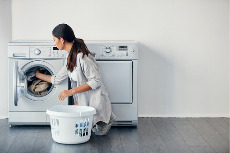
Laundry is one of those routine chores we do each week without thinking much about it. But the fact is, the way we go about washing our clothes could actually make a big difference in our wallet and, more importantly, the well-being of the planet. Try a few of these suggestions from Real Simple to cut back on the costs and reduce the environmental impact of doing laundry.
Use cold water. Did you know that nearly 90 percent of the energy associated with doing laundry comes from just heating up the water? This is an easy one to solve. Use cold water to wash your clothes instead. Many of today’s detergents are designed to be used with cold water and, therefore, your clothes will come out just as clean. Cold water will also help preserve your dark and brightly colored clothing.
Fill the washer to the max. It takes a lot of water—40 gallons for even the most energy-efficient machines—to run a load of laundry, so save water by cutting back on the number of loads you do each week by making sure you’re waiting until you have a full load to wash.
Upgrade to an energy-efficient washer and dryer. If it’s time to replace your washer and dryer, make sure you’re buying an energy-efficient model that saves both water and energy. This will also help lower your bills.
Consider natural laundry products. There’s a growing selection of natural laundry detergents and related products available to choose from today. Most are made from plant-based products and contain biodegradable ingredients. They’re also usually free of chlorine bleach, synthetic fragrances, dyes and optical brighteners. An added plus: Natural detergents are often specifically formulated to perform well in cold water.
Use non-chlorine bleach. When you do the math, it’s hard to argue. If every U.S. household replaced just one 64-ounce bottle of chlorine bleach with non-chlorine bleach, we could prevent 11.6 million pounds of chlorine from entering our environment.
Reduce drying time. Cut back on dryer use by hanging clothes to dry on a drying rack inside or outside your home. When you do use the dryer, make sure the lint trap is clean and that the vent isn’t clogged with lint, otherwise, it might take longer for clothes to dry. In addition, toss a few wool dryer balls in with sheets and towels, as they’ll absorb moisture and help speed drying time. They’re also an effective replacement for dryer sheets, which cannot be recycled.
Sort your laundry by weight. Don’t just sort your laundry by color, but rather, sort it by weight. Drying similarly heavy items together cuts back on drying time, so dry all your heavy towels together, and all your lightweight clothing items together.
Not only will these steps help the environment, they’ll result in cleaner, longer-lasting clothes, as well as linens.